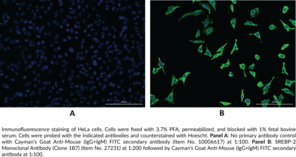Description
Sterol regulatory element-binding protein-2 (SREBP-2) is a membrane-bound transcription factor encoded by the SREBF2 gene in humans and is involved in the regulation of cholesterol biosynthesis and uptake.{13853,15316,15104} Similar to SREBP-1a and SREBP-1c, SREBP-2 is comprised of an N-terminal acidic domain, a basic-helix-loop-helix leucine zipper (bHLH-Zip) sequence, two transmembrane segments, and a regulatory C-terminal domain.{13853} In the absence of sterols, SREBP-2 undergoes two sequential proteolytic cleavage events resulting in release of the bHLH-Zip-containing N terminus from the endoplasmic reticulum membrane, followed by translocation to the nucleus.{13853,15316} Nuclear SREBP-2 (nSREBP-2) binds to sterol response elements (SREs) in DNA and regulates expression of genes encoding HMG-CoA synthase, HMG-CoA reductase, farnesyl diphosphate synthase, and squalene synthase, among others.{15316} Srebp2 is ubiquitously expressed in mouse tissues and knockout of Srebp2 is embryonic lethal in mice.{12882,15316} Hepatic expression of SREBF2 is seven- and three-fold higher in patients with non-alcoholic steatohepatitis (NASH) and steatosis, respectively, than that of healthy individuals.{48690} Cayman’s SREBP-2 Monoclonal Antibody (Clone 1B7) can be used for immunocytochemistry and immunohistochemistry applications.
Synonyms: SREBF2|Sterol Regulatory Element-binding Protein-2|Sterol Regulatory Element-binding Transcription Factor 2
Immunogen: Peptide from an internal region of the human SREBP-2 protein
Formulation: 100 µg of Protein G-purified monoclonal antibody
Isotype: IgG2b
Applications: ICC and IHC
Origin:
Stability: 365 days
Application|Immunocytochemistry||Application|Immunohistochemistry||Product Type|Antibodies|Monoclonal Antibodies||Research Area|Endocrinology & Metabolism|Metabolic Diseases|NAFLD & NASH||Research Area|Epigenetics, Transcription, & Translation|Transcription Factors||Research Area|Lipid Biochemistry|Sterol Lipids


